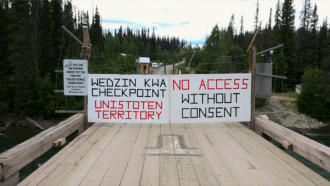Unist’ot’en Camp

Unist’ot’en Camp checkpoint
subMedia
Direct actionists fighting for social and environmental justice favor tactics of occupations and blockades. Usually these actions are primarily symbolic; their employment within a strategy of attrition minimizes their material impact. Tree-sitters occasionally win the preservation of a remnant grove in an otherwise clear-cut moonscape. Pipeline blockaders occasionally delay a project for a season or two until the police clear them out and construction is completed. Occupy Wall Street lit enthusiasm and drew global attention, but the balance of power between the 1% and the 99% has worsened.
The Unist’ot’en Camp was different. A handful of members of the Unist’ot’en clan of the Wet’suwet’en, in what Canada now calls British Columbia, blocked construction of seven tar sands and shale gas pipelines from 2011 through 2018. They didn’t even leave home to do so, merely occupied their land full-time and year-round, directly on the GPS coordinates of the proposed pipelines. They began by moving into a seasonal hunting cabin on the clan’s trapline. In the following years, they added rooms to the cabin and built a pithouse, a bunkhouse and a healing centre. They augmented their traditional subsistence activities with a garden and root cellar.
The tactic was unusually successful for several strategic reasons:
-
The mountainous terrain is a natural bottleneck limiting possible pipeline paths. The pipelines can’t easily be rerouted from the site of the Camp, let alone altogether out of Unist’ot’en territory.
-
Only a single road enters the territory, making border security enforcement relatively easy. The Unist’ot’en used this bottleneck to stop and screen prospective visitors at a one-lane bridge, rejecting entry requests from unwelcome government and corporate personnel. Surreptitious entry by air was no easier; on the few occasions on which company work crews flew in by helicopter, they were spotted and evicted.
-
The Unist’ot’en never ceded their land to Canada. With the clan retaining legal claim to their territory, pipeline companies had to weigh the risk of not being able to call on Canadian military and police forces to impose their own interests.
-
Historically, legalities have rarely stopped Canadian and other colonial governments from doing and taking what they want, but as the Unist’ot’en built up their physical infrastructure, they also built solidarity networks with other indigenous and with members of Canadian settler culture, garnering widespread grassroots support. The government didn’t risk interfering with the occupation until January 2019, when it invaded with militarized police prepared to kill defenders. (It invaded again in February 2020, this time sparking nationwide blockades of ports, highways, and rail. These crippled parts of Canada’s economy for weeks, demonstrating why the government left the Camp alone for so many years.)
It’s impossible to put an exact number on how many people and resources were required for the blockade’s success. Over the years, hundreds of visitors and volunteers participated in work and action camps, with supporters donating perhaps half a million dollars in cash and supplies. Most of the activity and money went towards educating settlers, assisting healing, and networking settler citizens and activists with indigenous resisters. This work was tangential to the blockade, but without the resultant broad support for the occupation, the government might have brutally suppressed it much sooner.
A relatively small portion of time and money built the core infrastructure for and directly maintained the blockade. Perhaps half a dozen indigenous residents anchored the ongoing tasks of guarding the bridge checkpoint, patrolling for aerial intrusion, providing for the camp via subsistence activities, and meeting and presenting in opposition to the pipelines, doing some of it directly plus organizing up to a dozen full-time equivalent volunteers.
Before having their territory forced open by the RCMP, this tiny group blocked multiple pipelines for 8 years. Even in 2019 and 2020, only Transcanada’s Coastal Gaslink Pipeline was under construction, and not until 2021 did Chevron float plans to revive its Pacific Trail Pipeline. The Unist’ot’en Camp is a prime example of minimum intervention for maximum impact.
The Wet’suwet’en people continue to fight the pipelines in court, but they have low odds of winning in a system rigged for corporations and profit. Likely, only further action “outside of the box” can permanently halt the pipelines.
A Caveat
It’s misleading to categorize the camp as “civil disobedience,” since its success depended on its legal claim to territory. No other environmental civil disobedience campaign has come close to comparable success, because uninhibited police forces quickly overpower them. We should take inspiration from the Unist’ot’en, but temper it with realism as to where similar tactics might be successfully replicated.
Learn more:
- February 2021 audio interview of Dr. Karla Tait (Unist’ot’en) and Anne Spice (Tlingit), describing the 2020 raids, how Transcanada exploited Covid to accelerate construction, and what comes next.
- Unist’ot’en Camp blog with current and archived news
- Unist’ot’en Camp in the context of indigenous resistance in Canada
- Background, early years, and culture of the camp: “Standing On the Land To Stand Up Against Pipelines”
- Other pipeline struggles:
Consider supporting our work by joining our mailing list below, sharing & "liking" this page, and following us on social media. You may freely republish this Creative Commons licensed article with attribution and a link to the original.